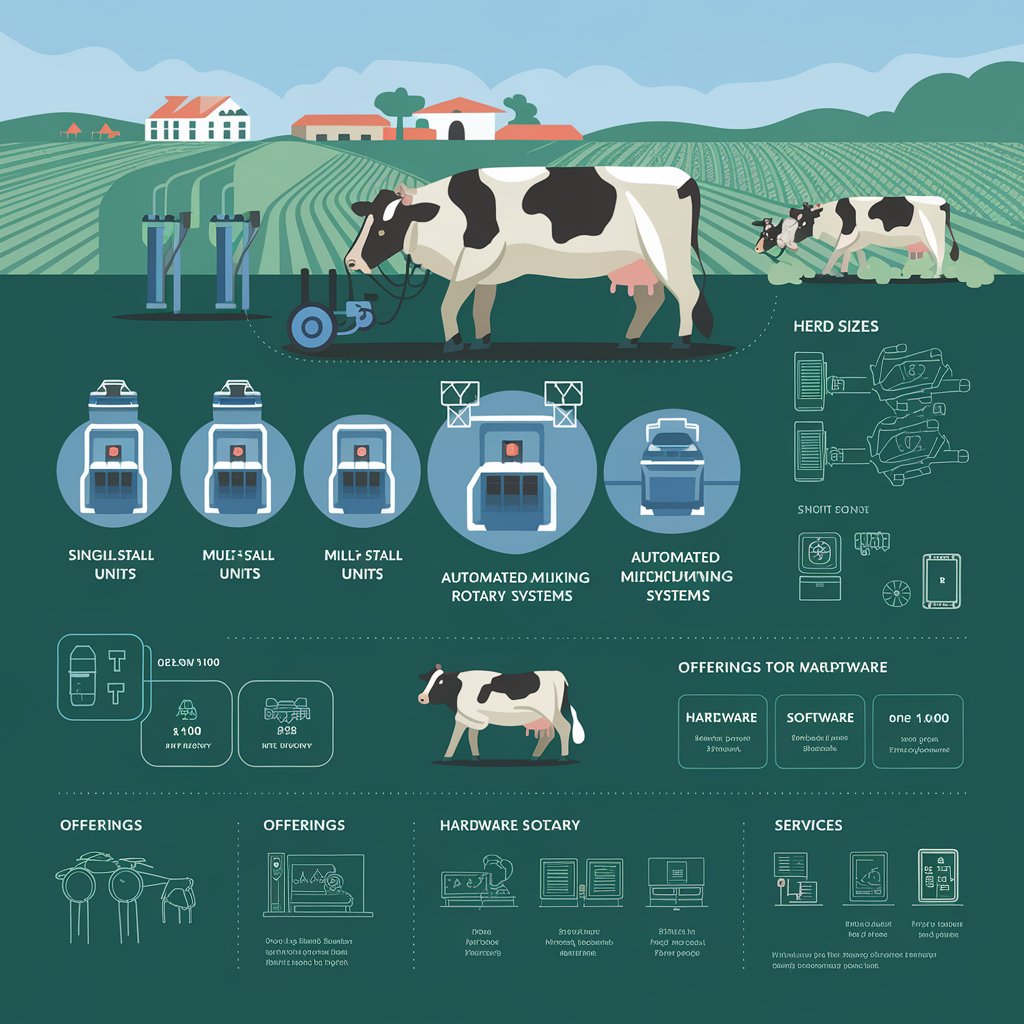Over the past few years, the growing need for automation in the agricultural sector has led to a dramatic revolution in the milking robots business. The use of milking robots is growing in popularity as dairy farms seek to increase output, improve animal welfare, and save labor expenses. The market growth forecast, major players, regional dynamics, opportunities, challenges, and industry segmentation will all be covered in this article along with the trends influencing the milking robots sector’s future.
Trends Shaping the Future of Milking Robots Industry
- Automation and Precision Farming
The future of the dairy business is largely dependent on automation. A larger trend toward precision farming, where data-driven technology guarantees more effective farming methods, includes milking robots. Automated systems enhance dairy herd management by tracking the productivity, health, and milk quality of cows. - Integration of IoT and AI Technologies
Milking robots are being revolutionized by the combination of artificial intelligence (AI) and the Internet of Things (IoT). Real-time data analysis by AI-enabled robots assists farmers in making well-informed choices regarding the feeding, milking, and overall health of their herds. It is anticipated that this development would result in more intelligent milking systems that can improve agricultural operations. - Sustainability and Animal Welfare
The development of milking robots is being influenced by the emphasis on bettering animal welfare and sustainable agricultural methods. More recent versions aim to lessen environmental effect and cow stress, supporting sustainability initiatives in the dairy sector. - Labor Shortages and Cost Efficiency
The use of milking robots by farmers is being driven by the lack of trained manpower in the agricultural sector. Large-scale dairy farms are easier to operate because to these systems, which also boost operational efficiency and lessen reliance on human labor.

Milking Robots Market Growth Projection
The global milking robots market is expected to witness substantial growth in the coming years, driven by the rising adoption of automated milking systems. According to industry forecasts, the global milking robots industry size is projected to grow from USD 3.2 billion in 2024 to USD 5.3 billion by 2029, registering a CAGR of 10.8% during the forecast period. The demand for improved productivity and reduced operational costs will continue to fuel this market expansion.
Top Companies in the Milking Robots Industry
Several companies are leading the charge in the development and deployment of milking robots, including:
- Lely: A global leader in robotic milking systems, Lely is known for its innovation in dairy automation.
- DeLaval: Offering a wide range of milking robots, DeLaval focuses on increasing farm productivity and sustainability.
- GEA Group: GEA provides high-tech solutions for automated milking systems with a focus on animal health and product quality.
- BouMatic Robotics: Specializing in precision dairy solutions, BouMatic Robotics is known for its reliable and efficient milking robots.
- Fullwood Packo: Fullwood Packo offers advanced robotic milking systems tailored to meet the needs of modern dairy farms.
Regional Analysis
- Europe is currently the largest market for milking robots, driven by strong adoption in countries like the Netherlands, Germany, and France. The region’s emphasis on precision farming and sustainability supports the growth of the industry.
- North America is also a significant market, with the United States and Canada showing strong demand due to the labor challenges and need for cost-efficient dairy operations.
- Asia-Pacific is expected to witness rapid growth in the coming years, especially in countries like China, Japan, and Australia, where dairy farming is increasingly adopting technological advancements.
- Latin America and Africa are emerging markets where adoption is slower but has significant growth potential due to the rise in commercial dairy farming.
Opportunities in the Milking Robots Industry
- Emerging Markets: As developing regions begin to modernize their dairy farming practices, there will be significant opportunities for milking robot manufacturers to expand into new markets.
- Technological Advancements: Continued innovations in AI, IoT, and robotics will create opportunities for companies to develop smarter and more efficient milking robots.
- Sustainability Initiatives: Increasing global focus on reducing the carbon footprint of farming operations will drive demand for energy-efficient and sustainable robotic systems.
Challenges Facing the Milking Robots Industry
- High Initial Investment: The high cost of purchasing and installing milking robots remains a barrier for smaller dairy farms, limiting market penetration.
- Technical Issues: While milking robots are designed to improve efficiency, technical malfunctions or maintenance requirements can disrupt farm operations, causing concerns for potential buyers.
- Farmer Adaptation: The adoption of new technologies in traditional dairy farms can be slow, especially for farmers who are not familiar with automated systems. Educating farmers on the benefits and usage of milking robots is essential.
Milking Robots Industry Segmentation
The milking robots industry can be segmented based on several key factors:
- Product Type:
- Single-stall milking robots
- Multi-stall milking robots
- Automated milking systems (AMS)
- Farm Size:
- Small farms
- Medium farms
- Large farms
- Geography:
- North America
- Europe
- Asia-Pacific
- Latin America
- Middle East and Africa
- Technology:
- Standalone robots
- Integrated robotic systems with IoT and AI
With developments in automation, artificial intelligence, and sustainability propelling market expansion, the milking robots sector has a bright future. The dairy sector will continue to change as the need for accurate and efficient operations grows, opening up new markets and potential for technological advancement. The potential advantages of milking robots outweigh the drawbacks, which include significant upfront costs and technical difficulties, making them a crucial component of contemporary dairy farming. The market for milking robots is expected to grow globally as more areas adopt robotic solutions.

